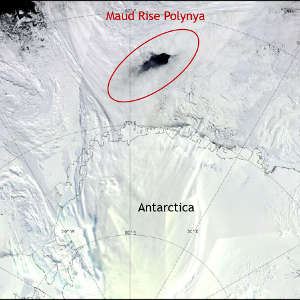River subbasins more depleted than
official figures show
09 April 2024
Published online 24 April 2019
Ice melt was not the cause of a vast opening in the Antarctic ice in 2017, as previously thought.

NASA Worldview
The formation of such expanses of open water within the polar ice—known as polynyas—is exceedingly rare. As such, the appearance of the Maud Rise polynya in the Weddell Sea in September 2017 offered scientists a truly once-in-a-lifetime research opportunity. “The last such event occurred over 40 years ago, and was not possible to study in detail because of a lack of data,” explains Diana Francis, a research scientist on Holland’s team and lead author on the study. However, scientists now know that this previous polynya triggered changes in deep ocean circulation that lasted for years afterward.
Many factors can affect the thickness and integrity of polar ice, including winds and variations in ocean temperature and salinity. After combing through the satellite data, however, Francis and colleagues linked formation of the ice breach with 12 hours of intense cyclone activity, with winds blowing at speeds of 100 kilometres per hour or higher. “The opening was not a result of ice melt as previously thought,” says Francis. “The strong winds exerted dynamical forcing on the ice and dragged it away from the centre in opposite directions, leading to the opening of the polynya.”
“It’s thought-provoking work, because it really does give you a sense of how the atmosphere, ice, and ocean are so well-connected,” says Marilyn Raphael, a climatologist at the University of California, Los Angeles (UCLA). However, she notes that it will be important to determine how atypical such cyclonic events are, and how other factors affecting ice conditions contribute to the formation of open-sea polynyas. “They obtained reasonable results from this case study, but now we have to go back and see if similar conditions occurred between 1974 and now, or if this was a singular event.”
Francis says a broader investigation is now in the works, with the goal of identifying both triggers and consequences of polynya formation. And as the planet continues to warm, these questions will only become more pressing. “We predict that the preconditioned areas for polynya formation will become closer to cyclone formation zones. Given the link we identified here, we speculate that polynya events might become more frequent under a warmer climate.”
doi:10.1038/nmiddleeast.2019.61
Francis, D. et al. Polar cyclones at the origin of the reoccurrence of the Maud Rise Polynya in austral winter 2017. J. Geophys. Res. Atmos. http://dx.doi.org/10.1029/2019JD030618 (2019).
Stay connected: